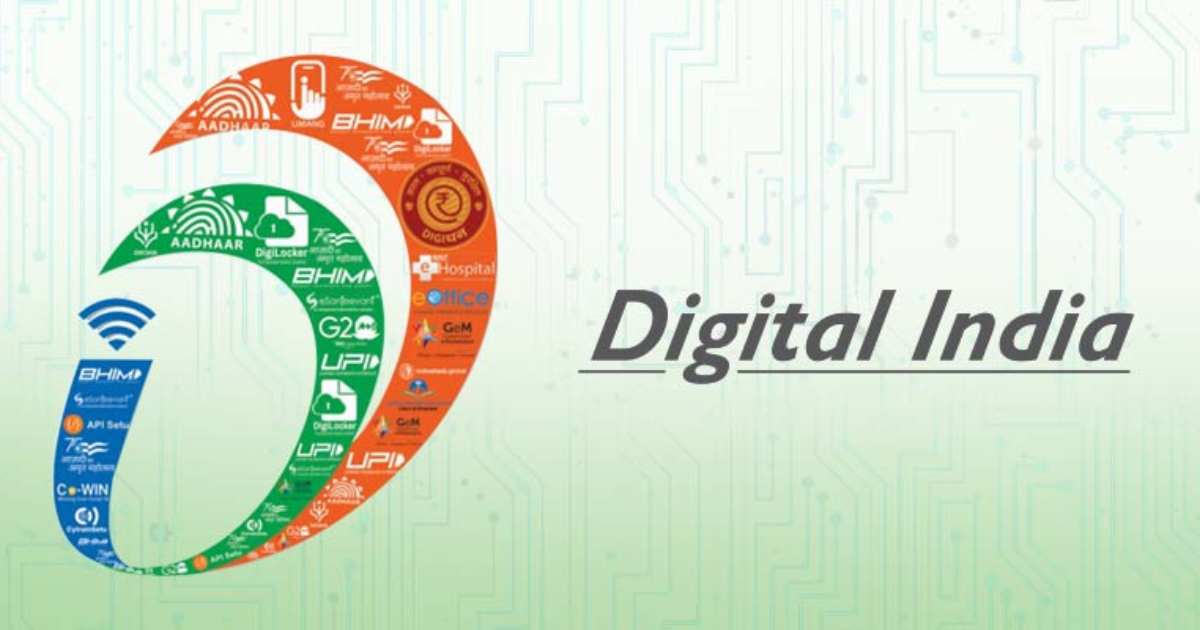The Digital India Yojana is one of the most ambitious initiatives launched by the Government of India to transform the country into a digitally empowered society and knowledge economy. Launched on July 1, 2015, by Prime Minister Narendra Modi, the program aims to bridge the digital divide and provide citizens with digital infrastructure, governance, and services.
By promoting e-Governance, digital literacy, and online services, Digital India has played a significant role in accelerating the adoption of technology in various sectors. This article explores how the initiative is transforming India, its objectives, key components, impact, challenges, and future prospects.
Objectives of Digital India Yojana
The Digital India Yojana is built on three key objectives:
- Digital Infrastructure as a Core Utility to Every Citizen:
- Ensuring high-speed internet connectivity in rural and urban areas.
- Providing digital identity (Aadhaar) for every citizen.
- Enabling secure and seamless banking services.
- Governance and Services on Demand:
- Enhancing transparency and accountability through e-Governance.
- Delivering government services electronically to reduce paperwork.
- Encouraging cashless transactions for financial inclusion.
- Digital Empowerment of Citizens:
- Promoting digital literacy and skill development.
- Encouraging the use of regional languages in digital platforms.
- Ensuring cyber security and data privacy for safe transactions.
Key Components of Digital India Yojana
1. Broadband Highways
To enhance digital connectivity, the government is developing broadband networks in rural and urban areas. Under the BharatNet project, high-speed internet has been extended to Gram Panchayats across India.
2. e-Governance – Digital Services for Citizens

The initiative has enabled access to various government services online, such as:
- DigiLocker – A cloud-based platform to store important documents.
- UMANG App – One-stop access to government services.
- e-Courts and e-Districts – Digitalization of legal and administrative processes.
- Passport Seva Kendra – Online passport application and processing.
3. Digital Payment Revolution
The promotion of cashless transactions has led to the rise of:
- UPI (Unified Payments Interface) – A seamless payment method.
- BHIM App – A government-backed digital wallet.
- Aadhaar-Enabled Payment System (AEPS) – Banking services using Aadhaar.
4. Smart Cities and Smart Governance
The Smart Cities Mission integrates technology in urban infrastructure, including:
- Intelligent traffic management systems.
- Waste management through IoT-based solutions.
- CCTV surveillance for public safety.
5. Make in India and Startup India Integration
Digital India supports Make in India by promoting domestic electronics manufacturing and encouraging startups in the tech sector. Initiatives such as Startup India and Standup India provide financial and mentorship support to emerging entrepreneurs.
6. Digital Literacy and Skill Development
Programs like PMGDISHA (Pradhan Mantri Gramin Digital Saksharta Abhiyan) have aimed to make 6 crore rural households digitally literate.
Impact of Digital India Yojana
1. Bridging the Digital Divide
- Over 1.5 lakh Gram Panchayats connected with broadband internet.
- More than 40 crore people linked to Aadhaar-based services.
- Increased smartphone penetration across rural and urban India.
2. Economic Growth and Job Creation
- The IT and digital services sector has expanded significantly.
- Growth in e-commerce, fintech, and digital banking sectors.
- Opportunities for freelancers and remote work have increased.
3. Transformation in Governance
- Paperless governance through e-Governance portals.
- Digital tax payments, e-filing, and transparent subsidy transfers.
- Direct Benefit Transfer (DBT) ensuring financial aid reaches beneficiaries directly.
4. Enhanced Financial Inclusion

- More than 50 crore bank accounts opened under Jan Dhan Yojana.
- Increased adoption of UPI, QR codes, and mobile wallets.
5. Education and Healthcare Digitalization
- Online learning platforms like SWAYAM and DIKSHA offer free courses.
- Telemedicine services through apps like eSanjeevani improving healthcare access.
Challenges in Implementing Digital India Yojana
Despite its success, Digital India faces several challenges:
1. Digital Divide and Connectivity Issues
- Rural areas still lack high-speed internet.
- Illiteracy and lack of digital skills hinder adoption.
2. Cyber Security Threats
- Increasing cases of cyber fraud and data breaches.
- Need for stronger cyber laws and digital safety measures.
3. Technological and Infrastructure Gaps
- Power shortages affecting internet services in remote areas.
- Insufficient digital infrastructure in small towns and villages.
4. Data Privacy and Digital Trust
- Concerns over Aadhaar-linked data security.
- Need for clearer data protection regulations.
Government Measures to Overcome Challenges
To address these challenges, the government has introduced:
- The Personal Data Protection Bill to enhance data security.
- Strengthening Cyber Security Cells across the country.
- Expanding 5G connectivity for faster and reliable digital services.
- Promoting digital literacy campaigns in rural areas.
Success Stories of Digital India Yojana
1. UPI – India’s Digital Payment Revolution
India’s UPI-based payment system has become one of the most successful digital payment methods, processing billions of transactions monthly.
2. Aadhaar-Enabled Services
From subsidy transfers to banking, Aadhaar has helped eliminate middlemen and corruption, ensuring benefits reach the right individuals.
3. E-Governance in Karnataka and Andhra Pradesh
States like Karnataka and Andhra Pradesh have adopted digital governance models that provide fast, transparent, and hassle-free services.
Also Read: How Swachh Bharat Yojana Is Transforming Sanitation In India?
Conclusion
The Digital India Yojana has played a crucial role in transforming India into a digitally empowered and technology-driven nation. With advancements in e-Governance, digital payments, broadband connectivity, and smart infrastructure, India is making significant strides towards becoming a global digital leader. However, bridging the digital divide, ensuring cyber security, and enhancing digital literacy remain key areas for future development.
FAQs
1. What is the main objective of Digital India Yojana?
The main objective is to digitally empower citizens, promote e-Governance, and ensure seamless digital services.
2. How has Digital India improved governance?
It has enabled paperless administration, online government services, and transparency through e-Governance platforms.
3. What is the impact of Digital India on financial inclusion?
It has promoted cashless transactions, digital banking, and financial inclusion through initiatives like UPI and Aadhaar-linked banking.
4. How does Digital India benefit rural areas?
- Provides internet connectivity to villages.
- Improves education through e-learning platforms.
- Enhances healthcare access via telemedicine.
5. What challenges does Digital India face?
- Internet connectivity issues in rural areas.
- Cyber security threats and data privacy concerns.
- Lack of digital literacy among older generations.

